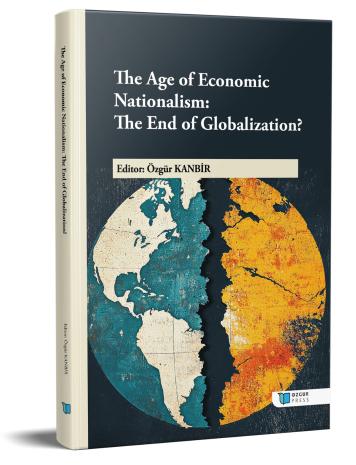
The Age of Economic Nationalism: The End of Globalization?
İndir
Özet
The foundational pillars of the liberal international order, established in the aftermath of World War II, are being shaken to their core. As we stand in 2025, the global economy is at a critical inflection point. The wave of economic nationalism and protectionism, reignited with force by former US President Trump, clearly demonstrates that trade is no longer merely an engine of economic growth but has become a primary instrument of geopolitical tension and the struggle for sovereignty.
For decades, globalization and free trade guided the global economy with the promise of shared prosperity. However, deepening inequalities since the 2008 Global Financial Crisis, coupled with the rise of "national interest" rhetoric, have fueled a resurgence of neo-mercantilist policies. The strategies pursued by the US through tariffs, supply chain restrictions, and geo-economic security concerns show that the global economy has transformed into an arena dominated by “weaponized trade” and “new protectionism.”
At this critical juncture, this edited volume aims to provide a robust analytical framework for a global readership to understand this multidimensional transformation. Going beyond populist rhetoric, this collection seeks to reveal the chronic structural problems behind the current trade wars and their long-term effects on the international order. Starting with conceptual foundations, the book examines this new era through eight distinct lenses, ranging from the structural economic causes of conflict to policy instruments and corporate adaptation strategies.
The first chapter, “Trade Wars in The Context of Economic Nationalism and The Search for Sovereignty” by Ali Kırıktaş and Özgür Kanbir, establishes the theoretical and conceptual framework of the book. The chapter defines economic nationalism as an approach where economic activities are marshaled to serve national interests and goals. It examines the historical origins of economic sovereignty and its transformation in the age of globalization. By comparing Realist and Constructivist approaches, it demonstrates that the US-China competition is both a material power struggle and a clash of worldviews. This section emphasizes how the contemporary quest for technological supremacy and supply chain security adds new dimensions to the traditional understanding of sovereignty. This theoretical and conceptual framework lays the groundwork for the second chapter, which delves into the historical and philosophical roots of this resurgence.
Building on this foundation, the second chapter, “Surviving in the Age of Economic Nationalism: The Price of Protectionism and Neo-Mercantilism” by Mustafa Acar, focuses on the historical and philosophical underpinnings of modern protectionism. The chapter introduces the fundamental propositions of mercantilism and contrasts them with classical liberal critiques from Adam Smith to David Ricardo. Professor Acar critically evaluates the neo-mercantilist approach, refuting protectionist arguments (national security, infant industries) with arguments for the prosperity, lower prices, and moral superiority that free trade provides. This comparison reveals that the cost of protectionism is ultimately borne by consumers and export sectors. While Professor Acar masterfully contrasts the philosophical arguments for and against free trade, the third chapter examines the concrete, modern-day policy instruments of this new protectionist wave.
The third chapter, “Tariffs and Trade Wars: The Rise of Protectionism in The Global Economy” by Fatma Pınar Eşsiz, examines this new wave of protectionism in the context of geoeconomic security. The chapter addresses the idea that, especially since the 2008 crisis, trade has been weaponized as a geopolitical tool. The US "America First" policies serve as a concrete example of this transformation. The chapter shows that protectionism has evolved beyond traditional tariffs to encompass technology, environmental regulations (like the EU's Carbon Border Adjustment Mechanism), and the quest for strategic autonomy. It also analyzes how the COVID-19 pandemic exposed the fragility of global supply chains, accelerating this weaponization of trade. This focus on geoeconomic tools finds its most prominent case study in the US-China conflict, which is the subject of the following chapter.
The fourth chapter, prepared by Özgür Kanbir, is titled “The Economic Policy of the US-China Trade War.” This section advances the thesis that the trade war is merely a symptom of deeper, internal structural problems within the US economy. The analysis centers on the chronic “low savings-low net investment” paradox that has plagued the US for decades, a weakness sustained by the “exorbitant privilege” of the dollar's global reserve status. The data-driven analysis demonstrates that the costs of the Trump-era tariffs were borne not by China but by US consumers and producers, and that the trade deficit was not eliminated but merely shifted to other countries through “trade diversion.” Kanbir's analysis of national structural issues leads naturally to the question of how domestic policies, such as competition law, are being reshaped by the pursuit of national interests.
This question is addressed in the fifth chapter, “Competition Policy and National Interests,” co-authored by Jafar Babayev and Shamsi Rzali. The chapter explores the structural tension between competition law, which aims to protect market efficiency, and the state’s desire to support strategic sectors through subsidies and protective regulations. Central to managing this tension is the Regulated Conduct Doctrine (RCD), which allows for exemptions from competition law scrutiny for actions compliant with legitimate regulatory frameworks. The chapter emphasizes that competition policy requires adaptive, multi-level governance to avoid becoming either a shield for protectionism or an obstacle to legitimate state action. From the general tension between competition and national interest, the book then turns to a specific and potent case of financial nationalism in an EU member state.
The sixth chapter, “From Liberal Orthodoxy to Illiberal Democracy: Hungary’s Turn Toward Financial Nationalism” by Onur Oğuz, provides an in-depth case study of the illiberal turn in financial markets. It details the strategies of Hungary, led by Viktor Orbán, to regain monetary sovereignty in the wake of the 2008 crisis. These measures include reducing foreign currency debt, nationalizing major banks to decrease foreign ownership below 50%, and demanding the closure of the IMF office. This case study serves as a powerful example of how illiberal policies position national interests against the liberal global system. Hungary's example in the financial sector is mirrored in another critical area for national sovereignty: agriculture and food security.
The seventh chapter, “Economic Nationalism and Agricultural Policies: A Panel Data Analysis” by Burcu Yılmaz Şahin and Halit Levent Orman, empirically analyzes the impact of economic nationalism on this vital sector. Focusing on emerging economies like India, Turkey, Russia, and China, the panel data analysis reveals that while trade openness has historically had a negative effect on the agricultural sector's share of GDP, recent nationalist policies and food crises have begun to reverse this trend in some countries. The study argues that policymakers must consider country-specific structures and the importance of protective measures. While states erect protectionist barriers, multinational corporations are not passive actors. The final chapter explores a key adaptive strategy they have developed in response.
The eighth and final chapter, “Reverse Innovation: A New Perspective on Globalization” by Hasan Önder Sarıdoğan, presents this adaptive strategy. Contrary to the traditional top-down flow of innovation, Reverse Innovation describes the process where products developed for low-income countries are subsequently introduced to high-income markets. This strategy enables transnational corporations to seize growth opportunities and overcome regional barriers in an era of "slowbalization." Reverse Innovation demonstrates that globalization is no longer a unidirectional force but a multidimensional phenomenon shaped by actors at all levels.
This volume provides a roadmap for making sense of the complex picture presented by economic nationalism and trade wars in the turbulent 21st century. The analyses show that this new era has reshaped not only international trade rules but also the very definition of state sovereignty, the tools of national economic governance, and the strategic behavior of global firms. At a time when the fundamental pillars of the global order are being shaken, our primary goal is for this book to offer the international community and policymakers a more nuanced, data-driven, and in-depth perspective. Ultimately, this collection argues that the rise of economic nationalism is not a fleeting political trend but a structural transformation of the global system, demanding that we fundamentally rethink the old certainties of globalization.

